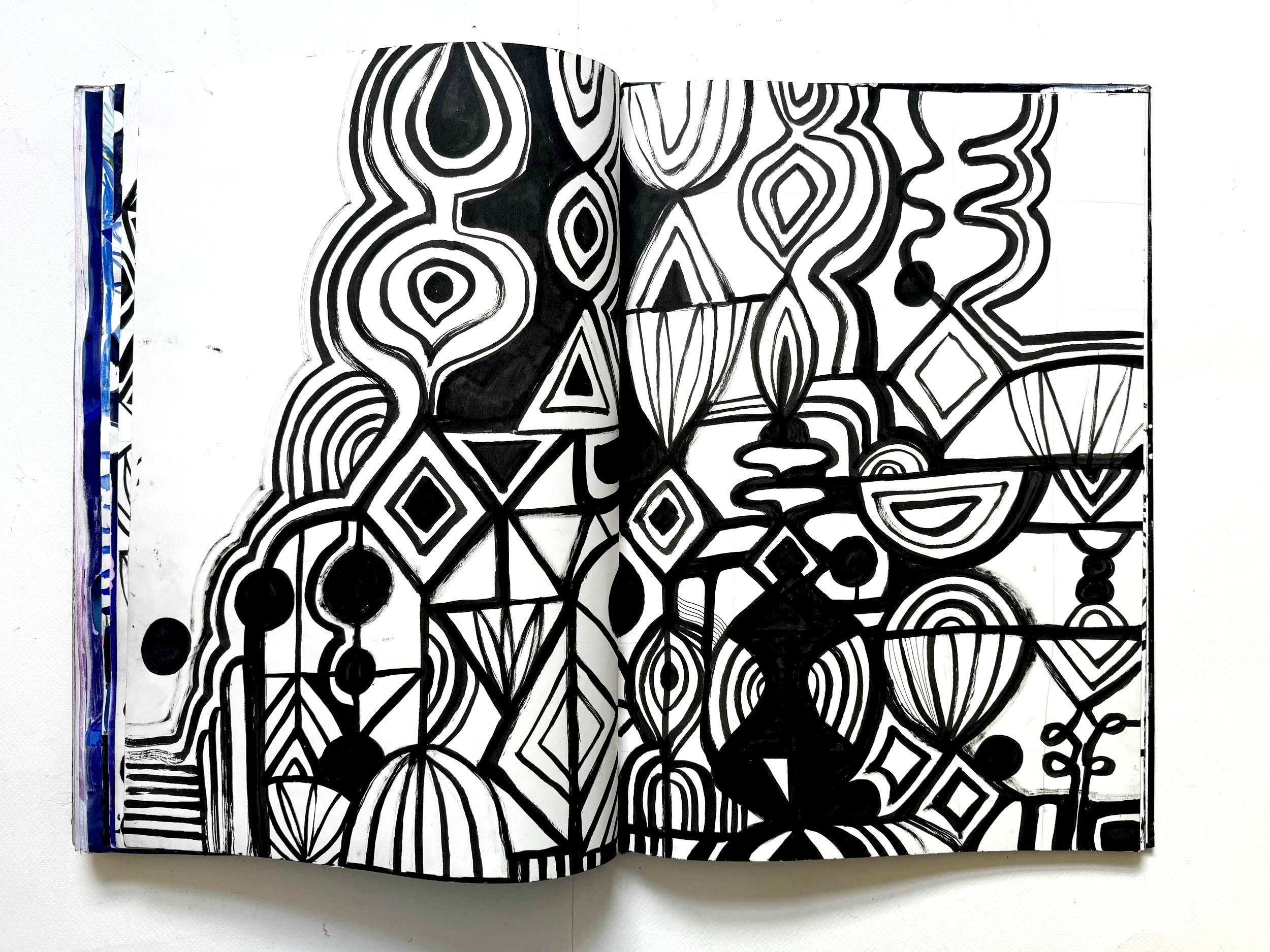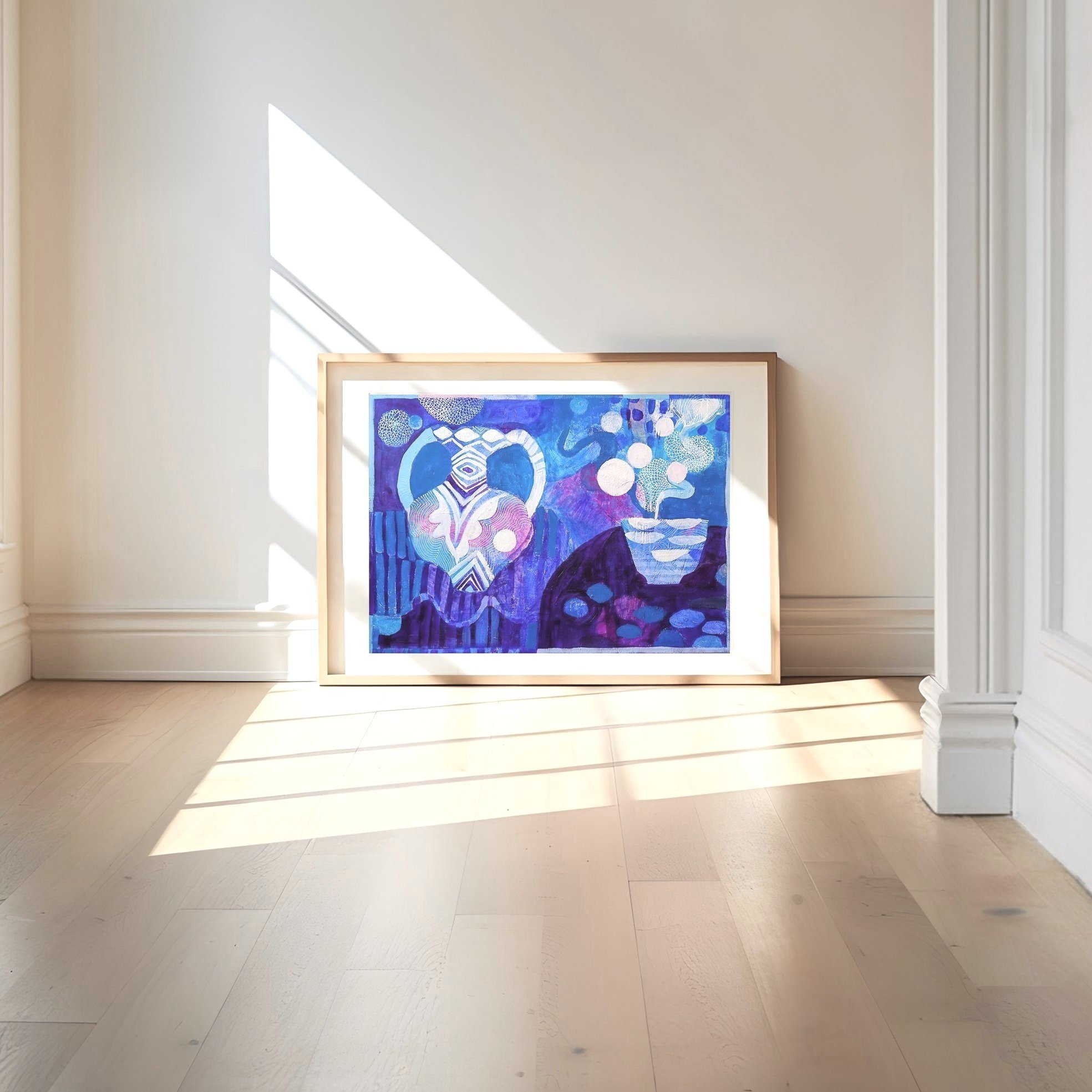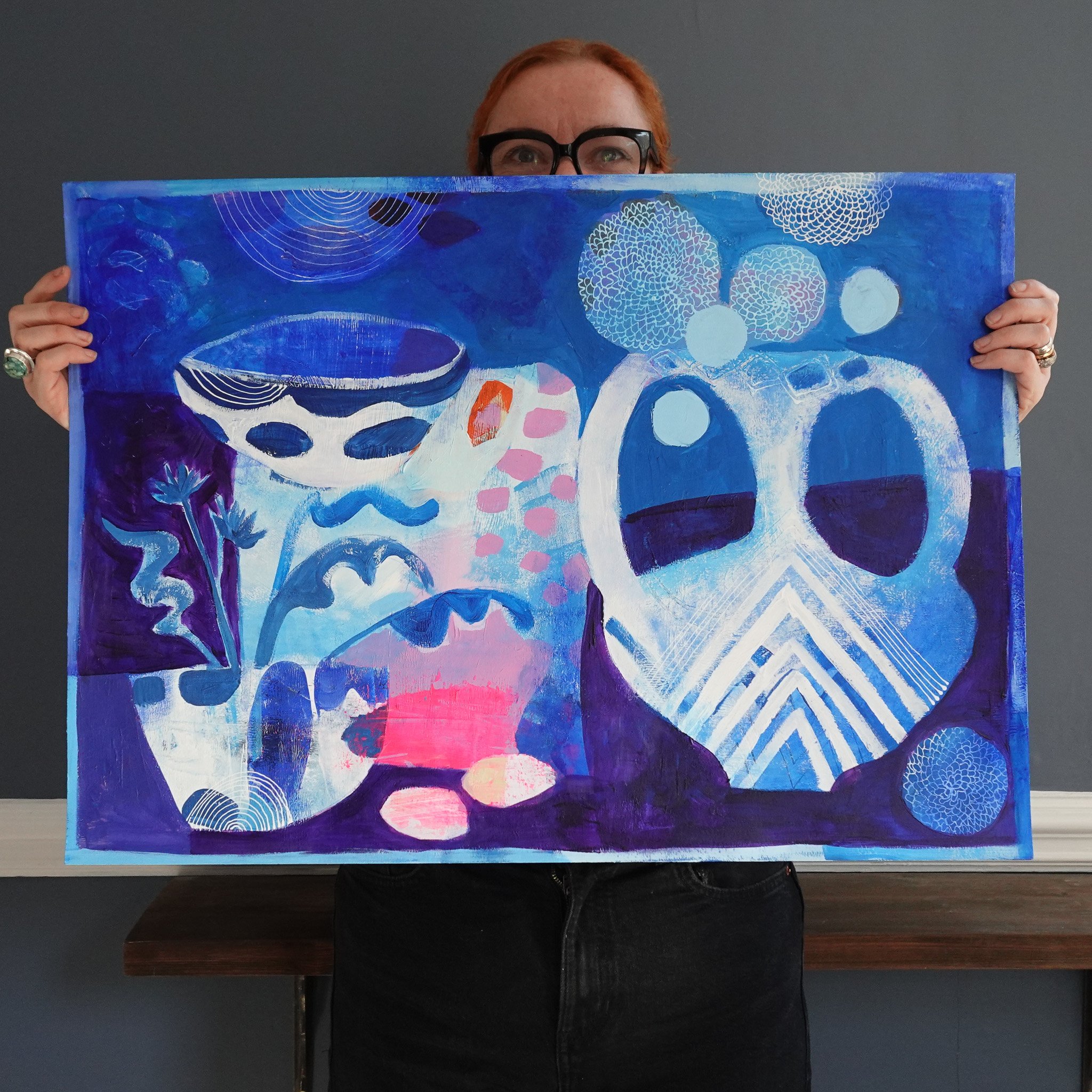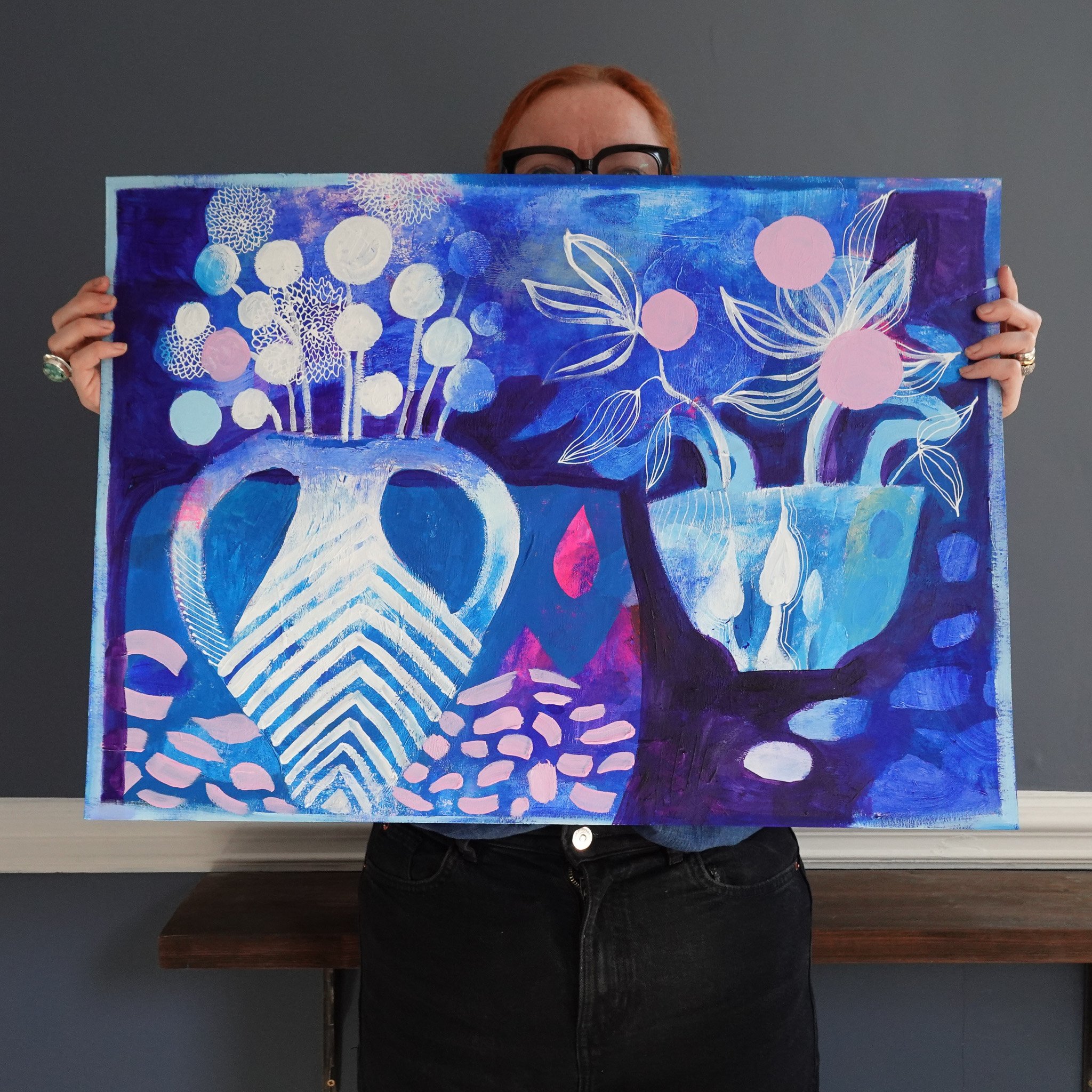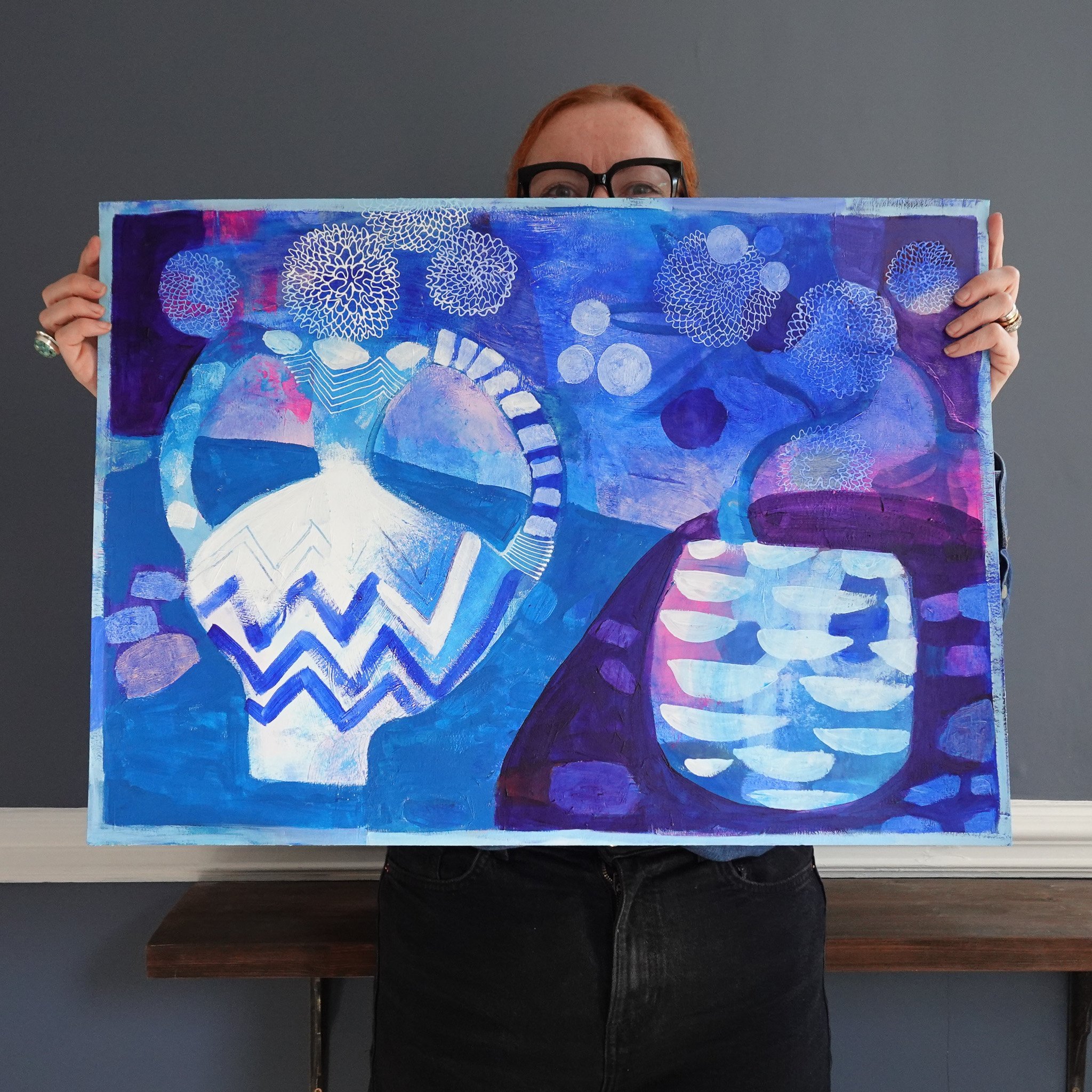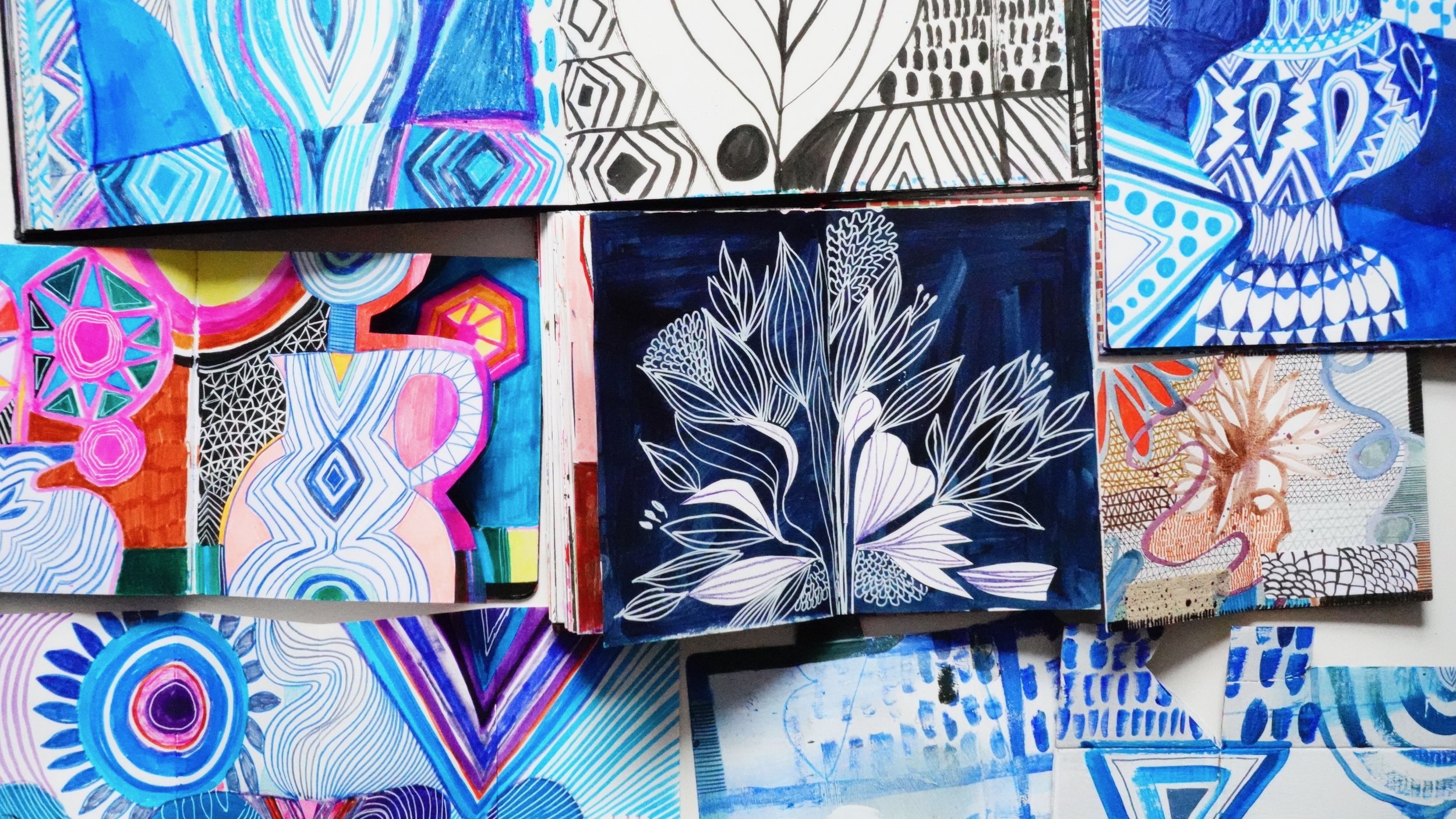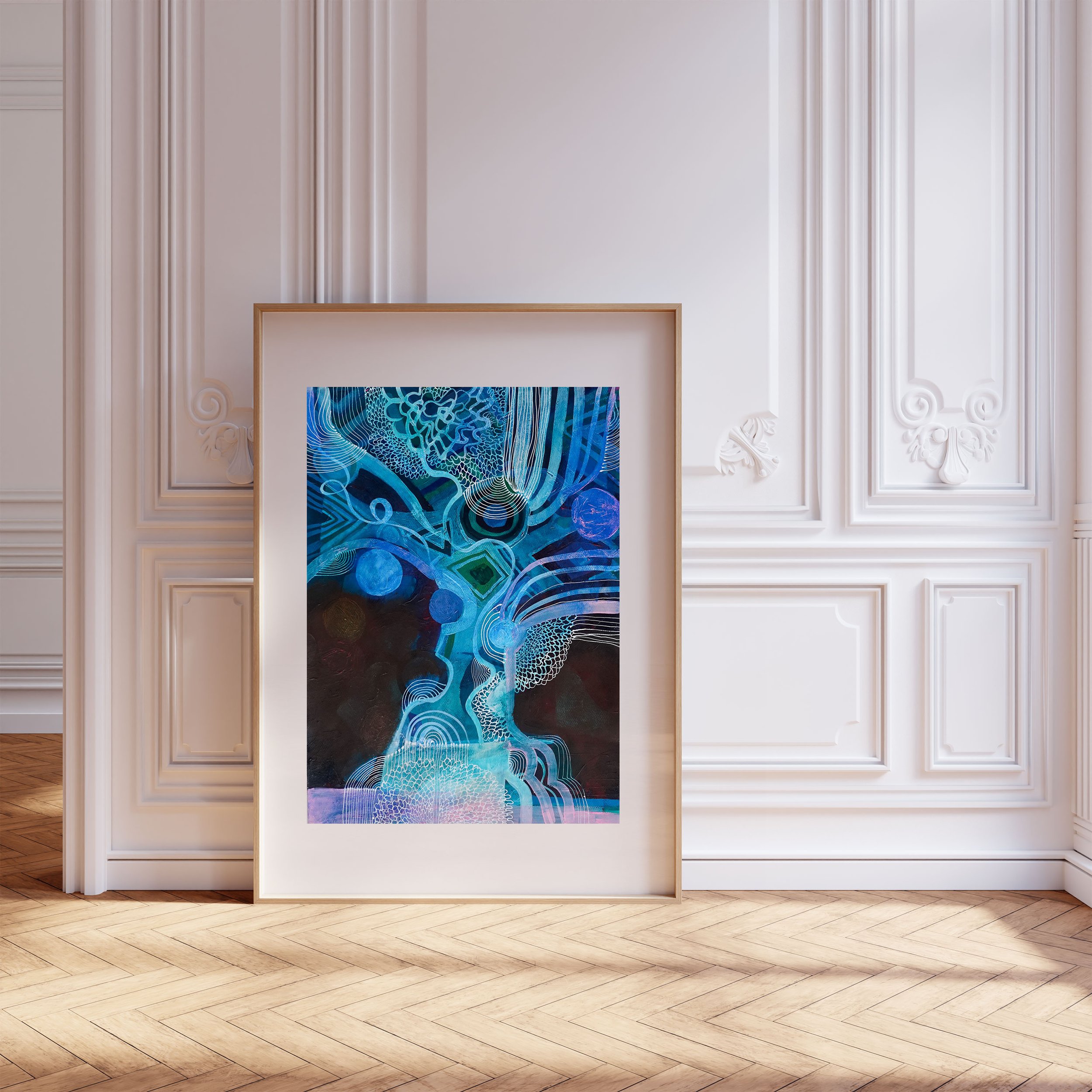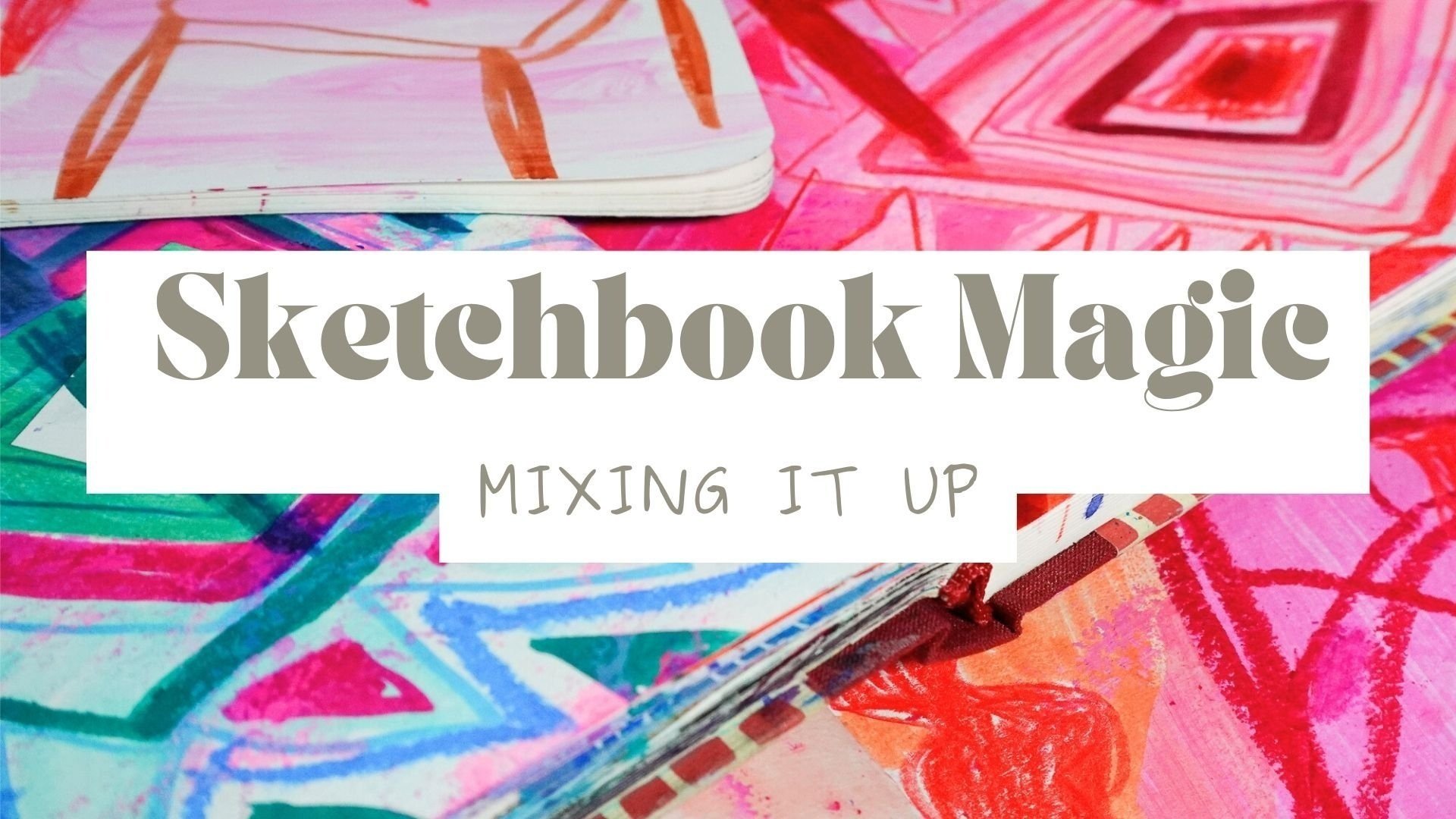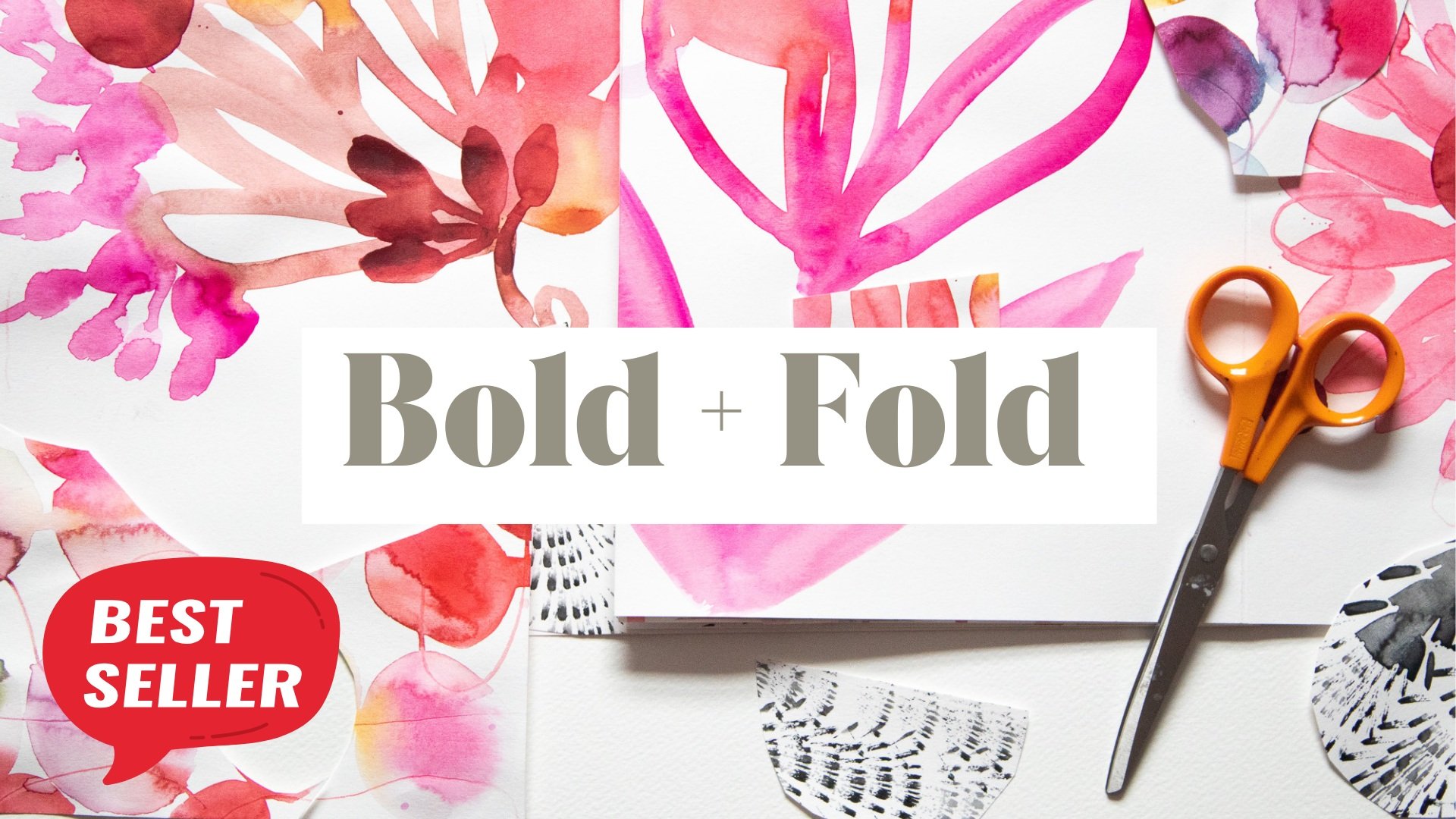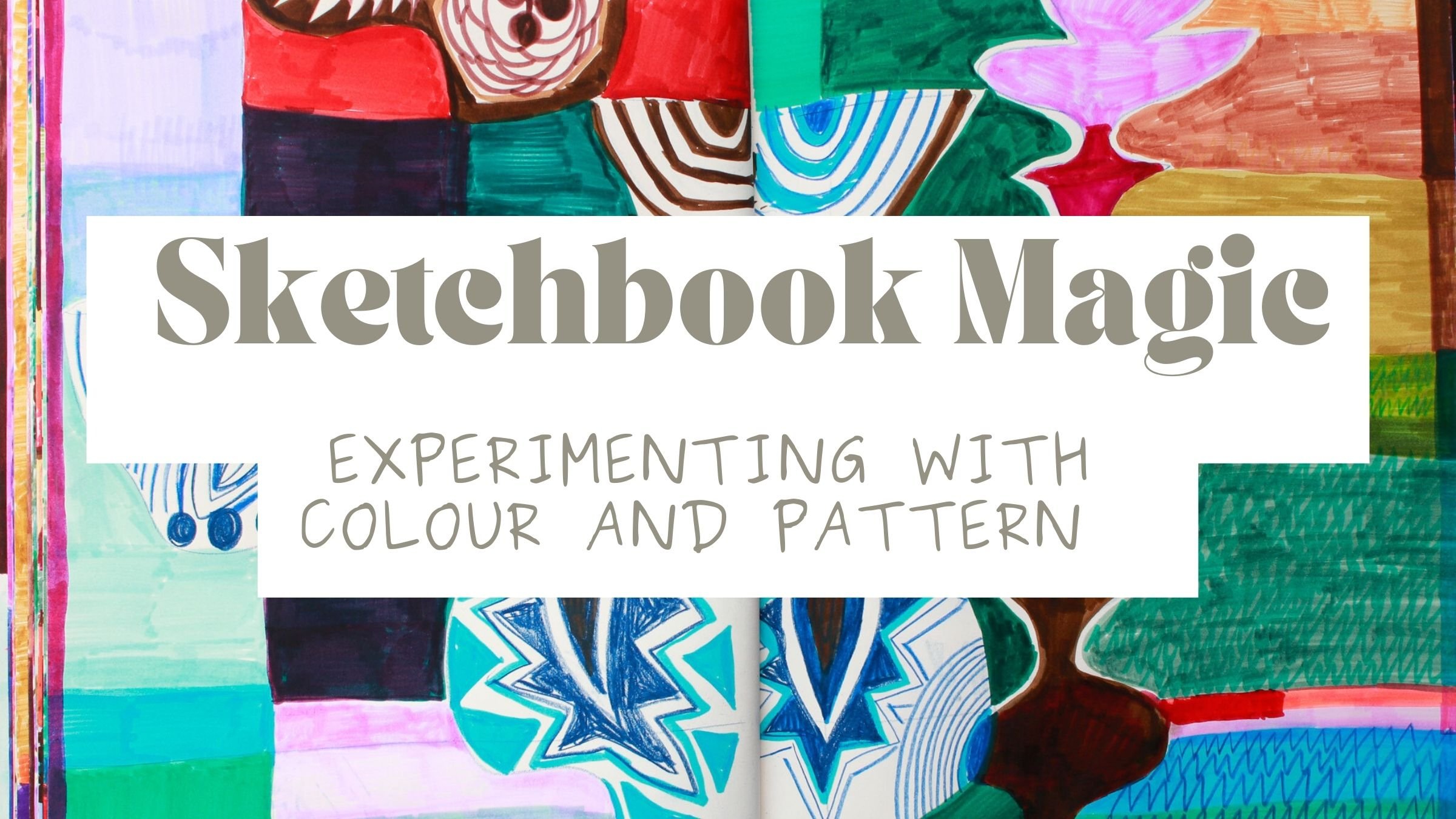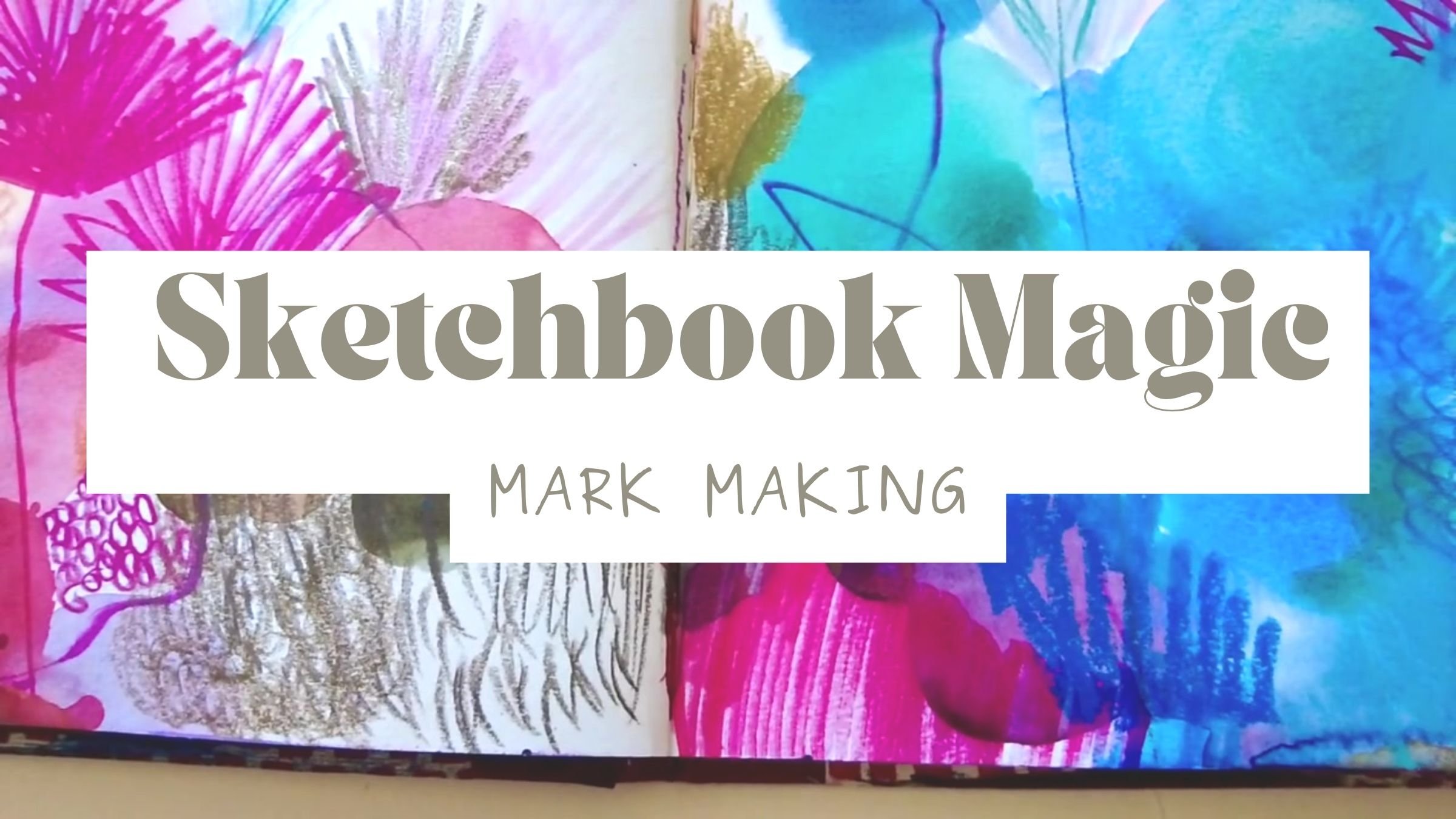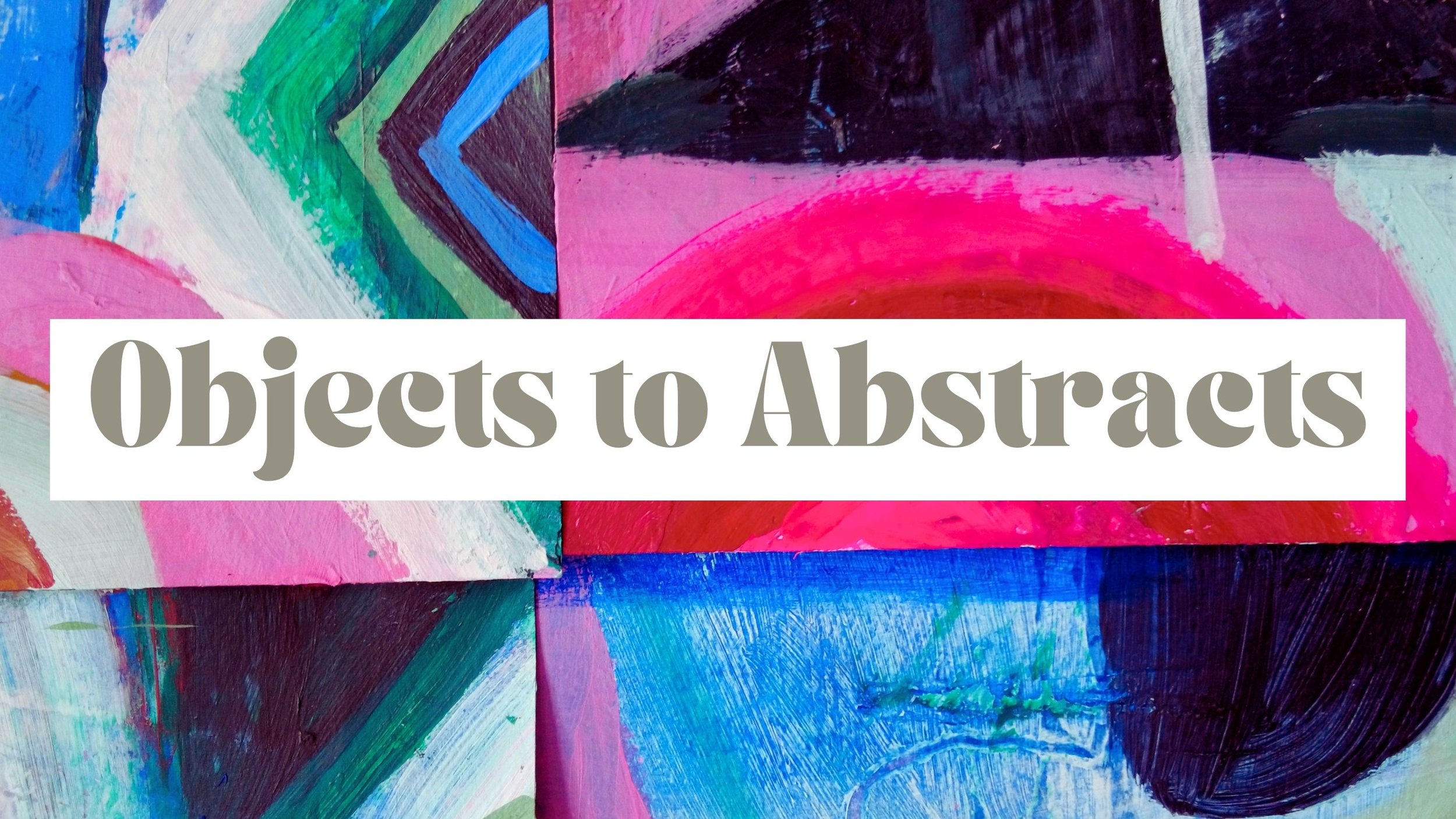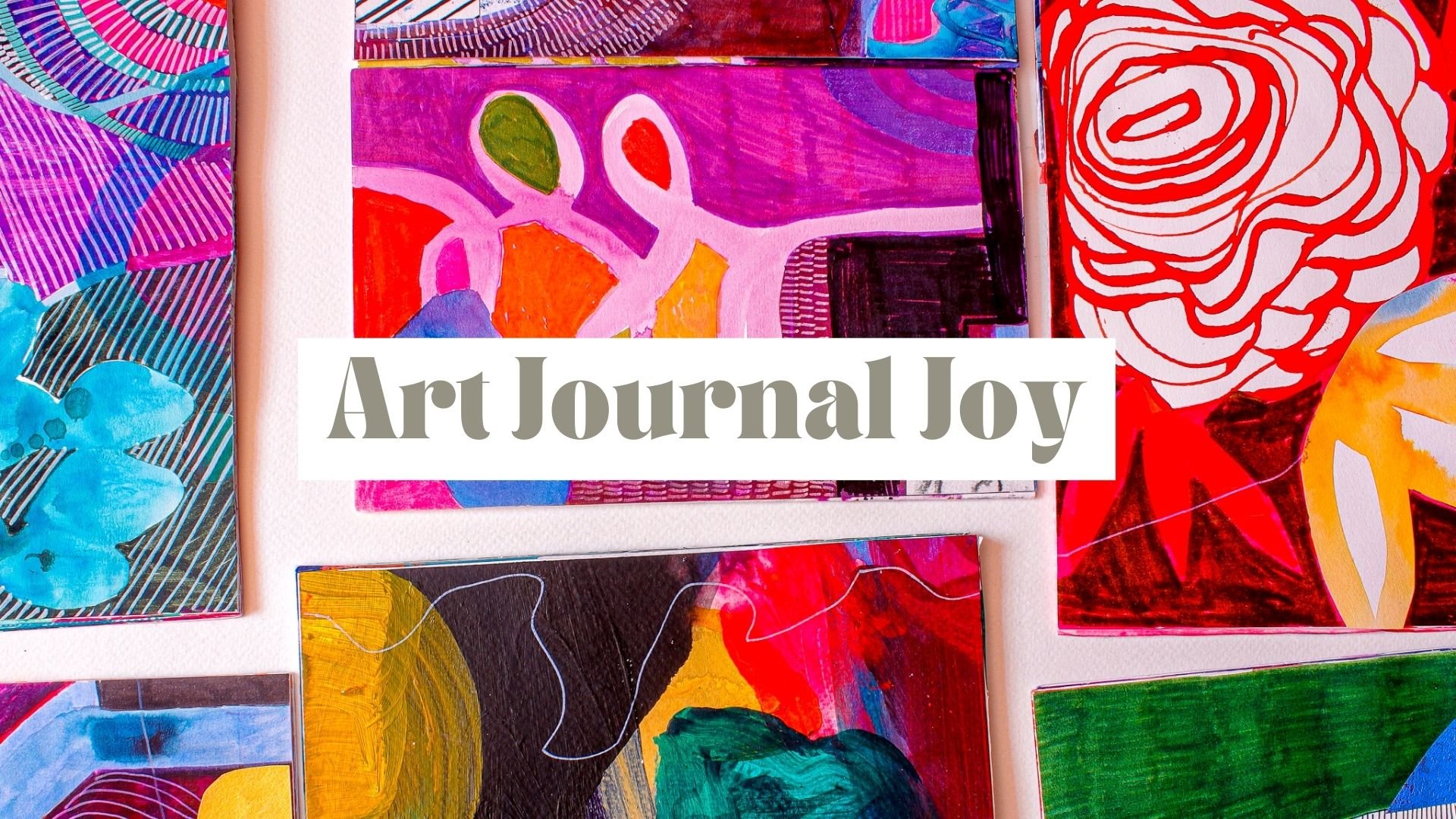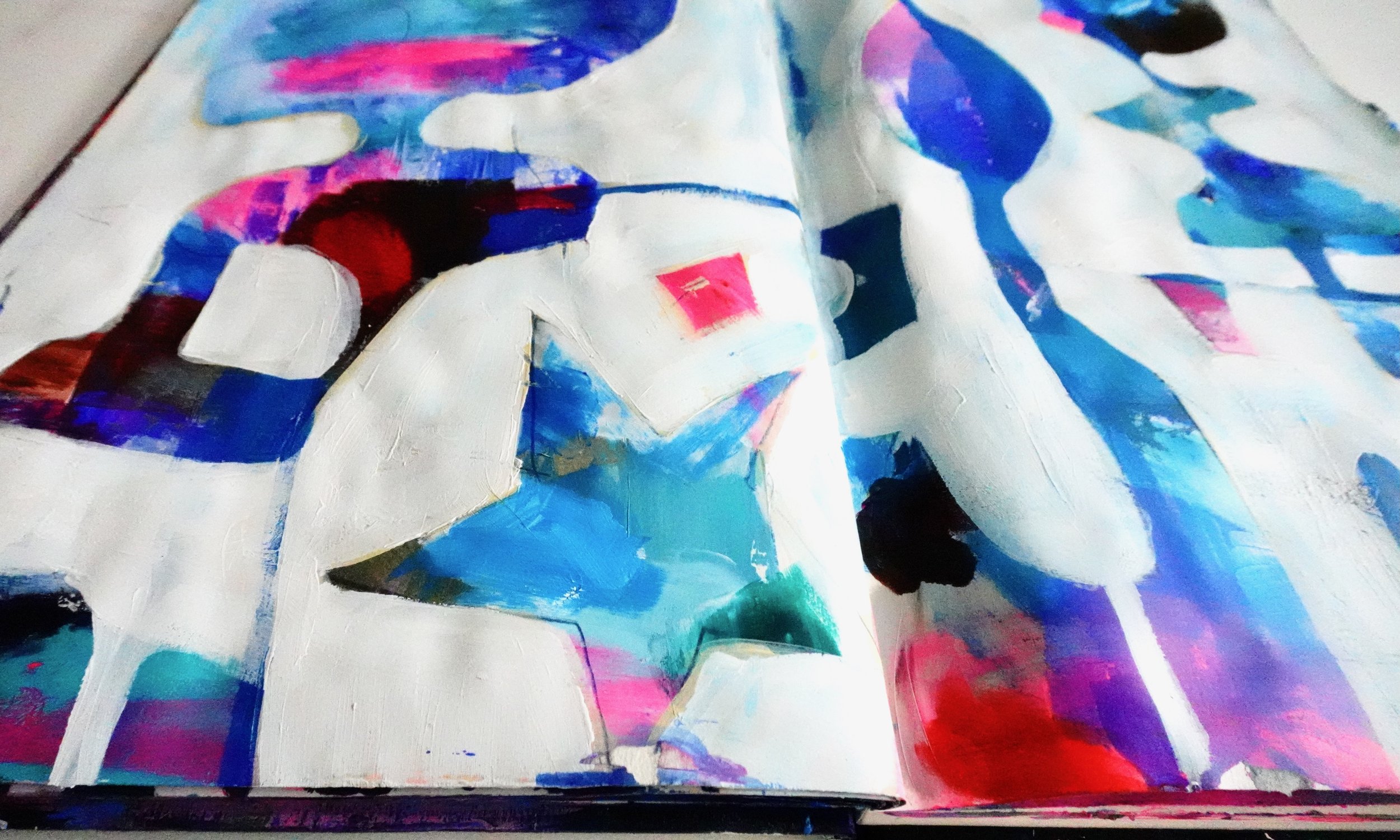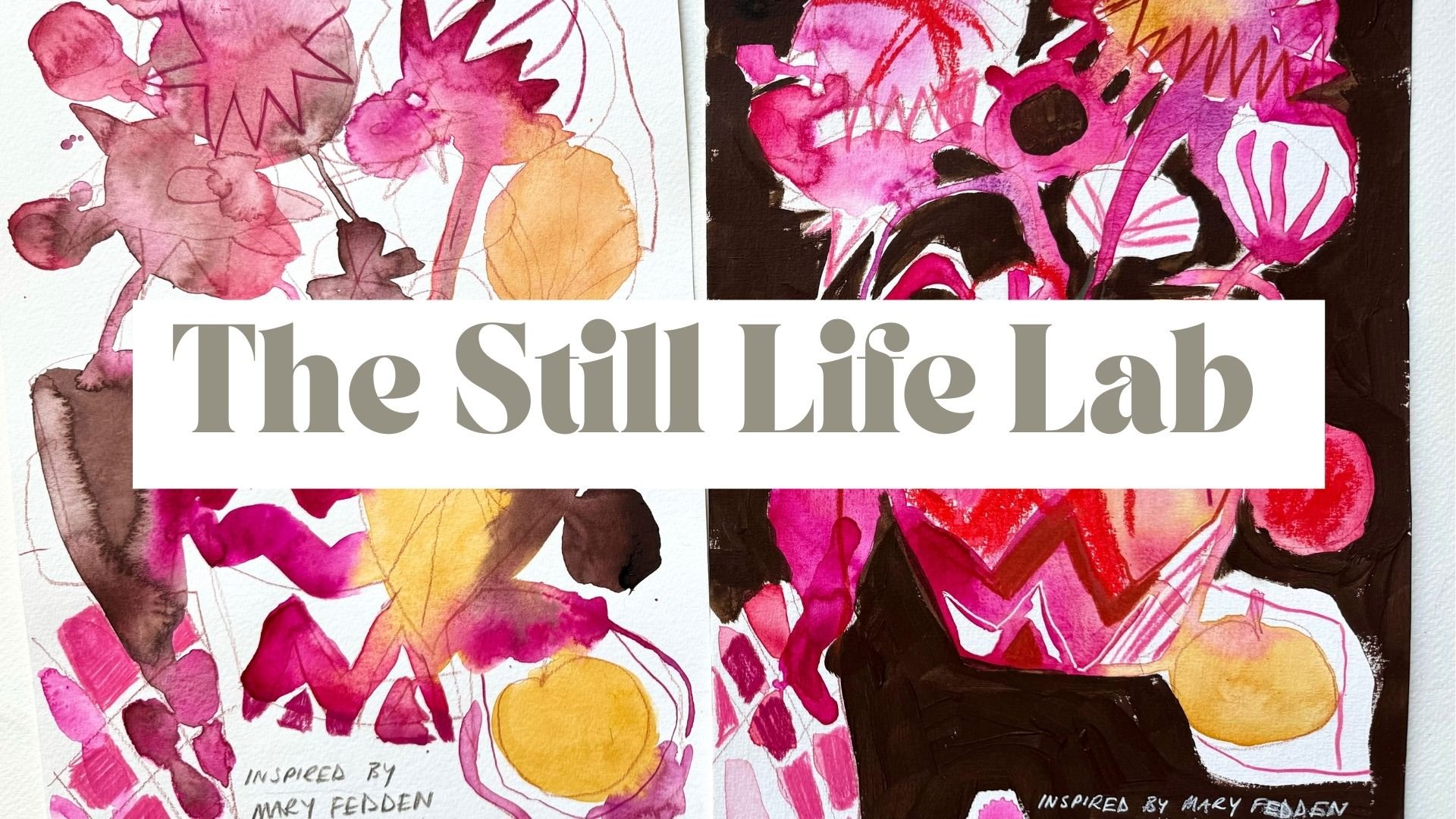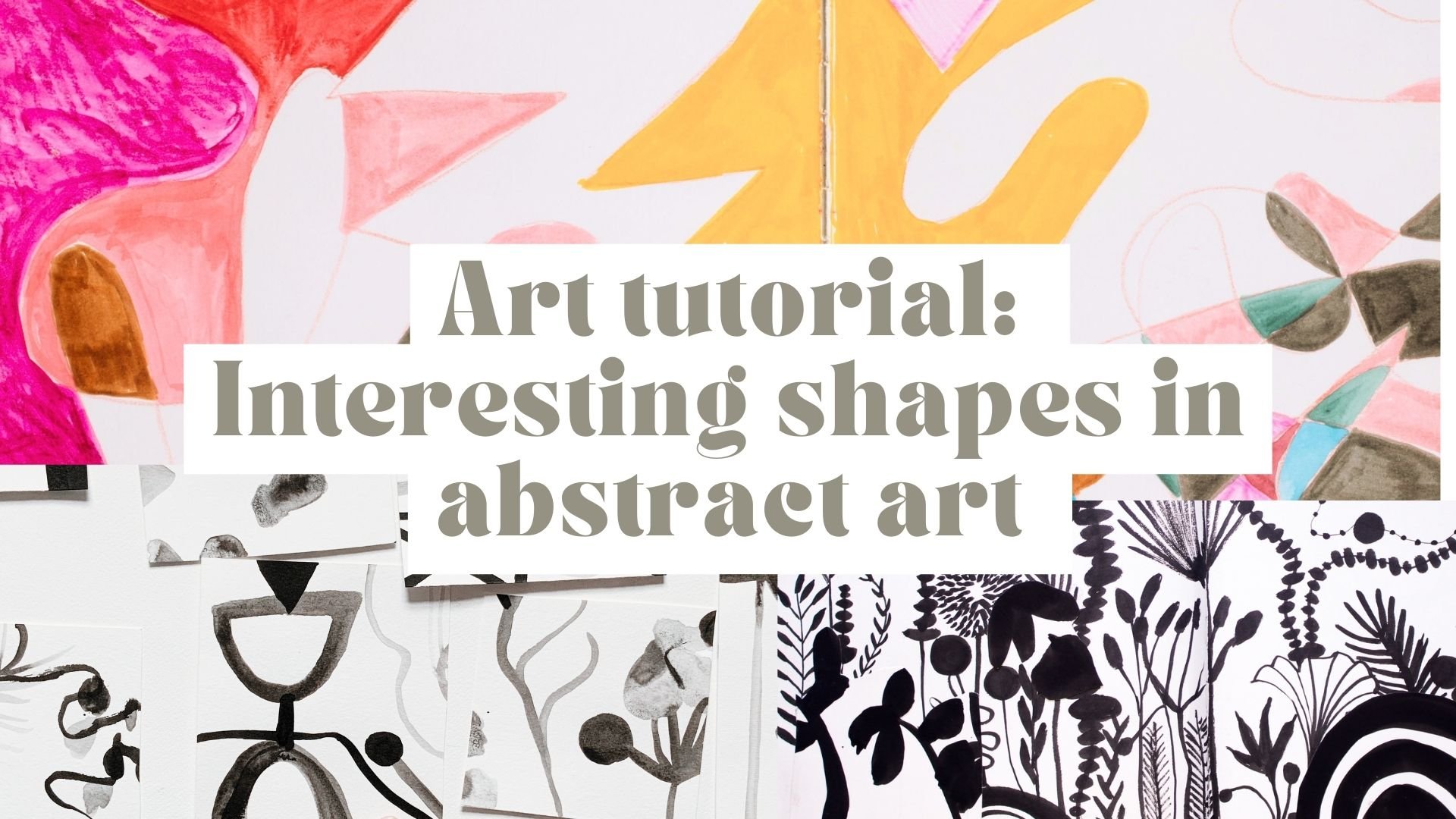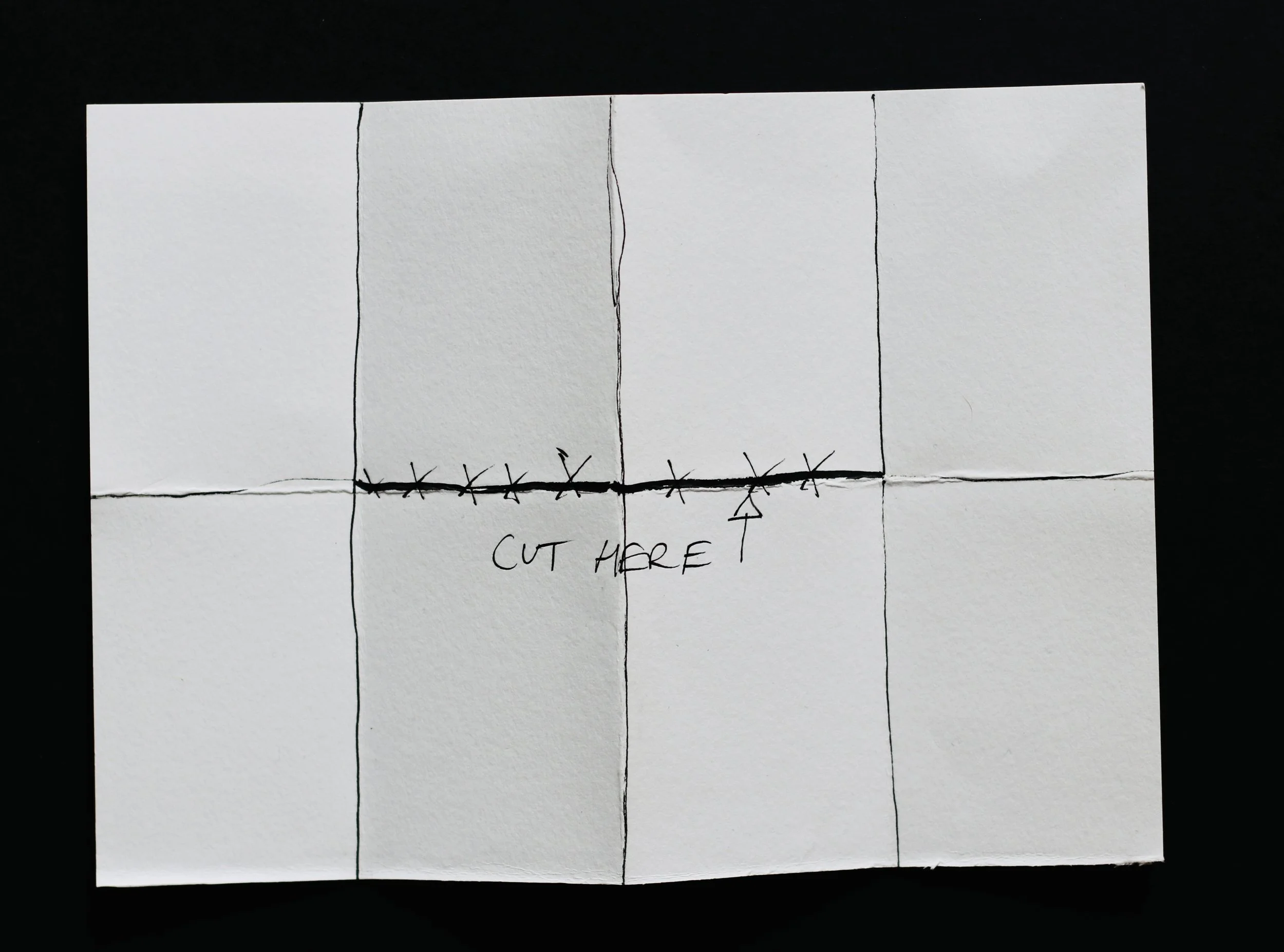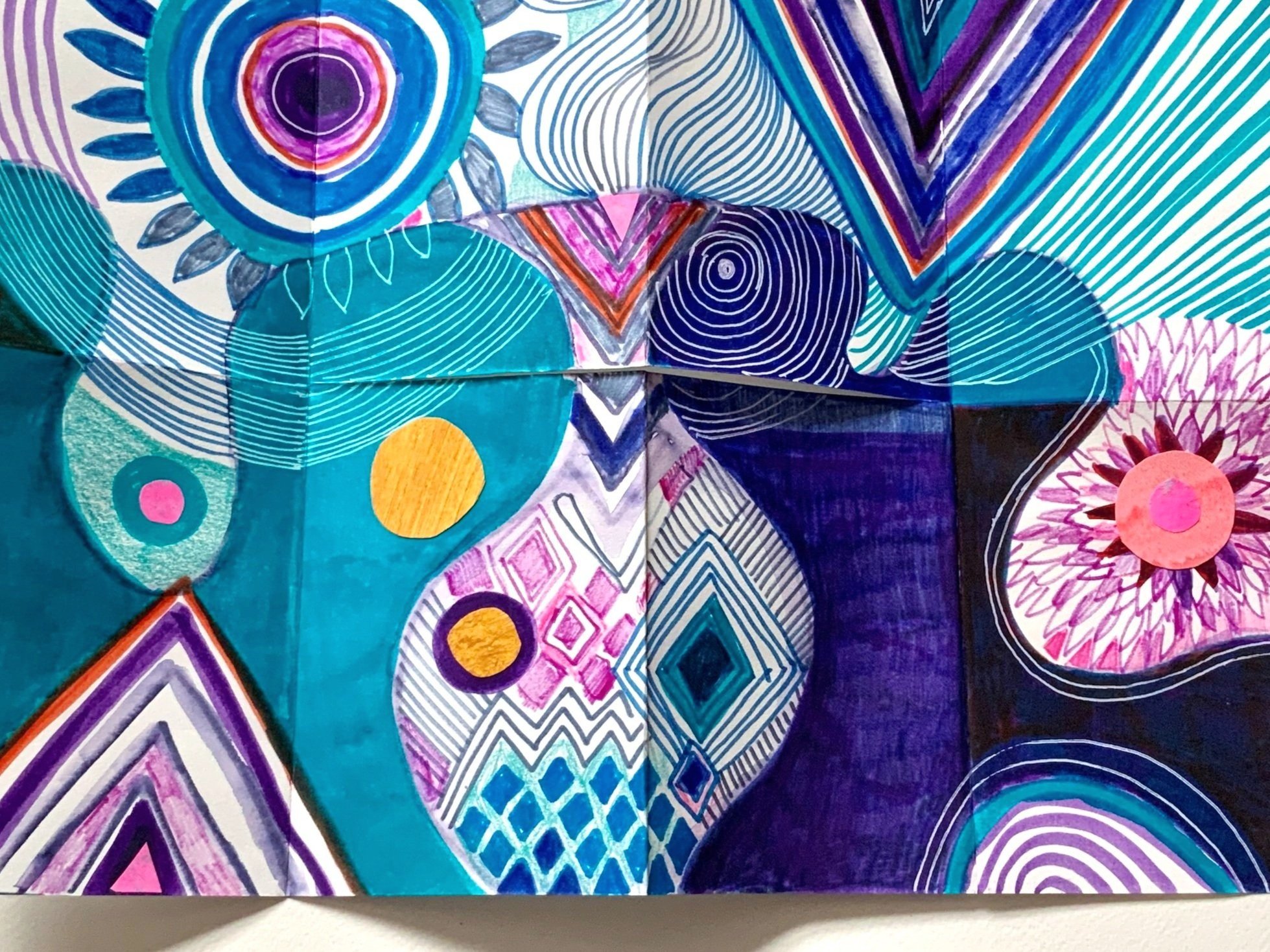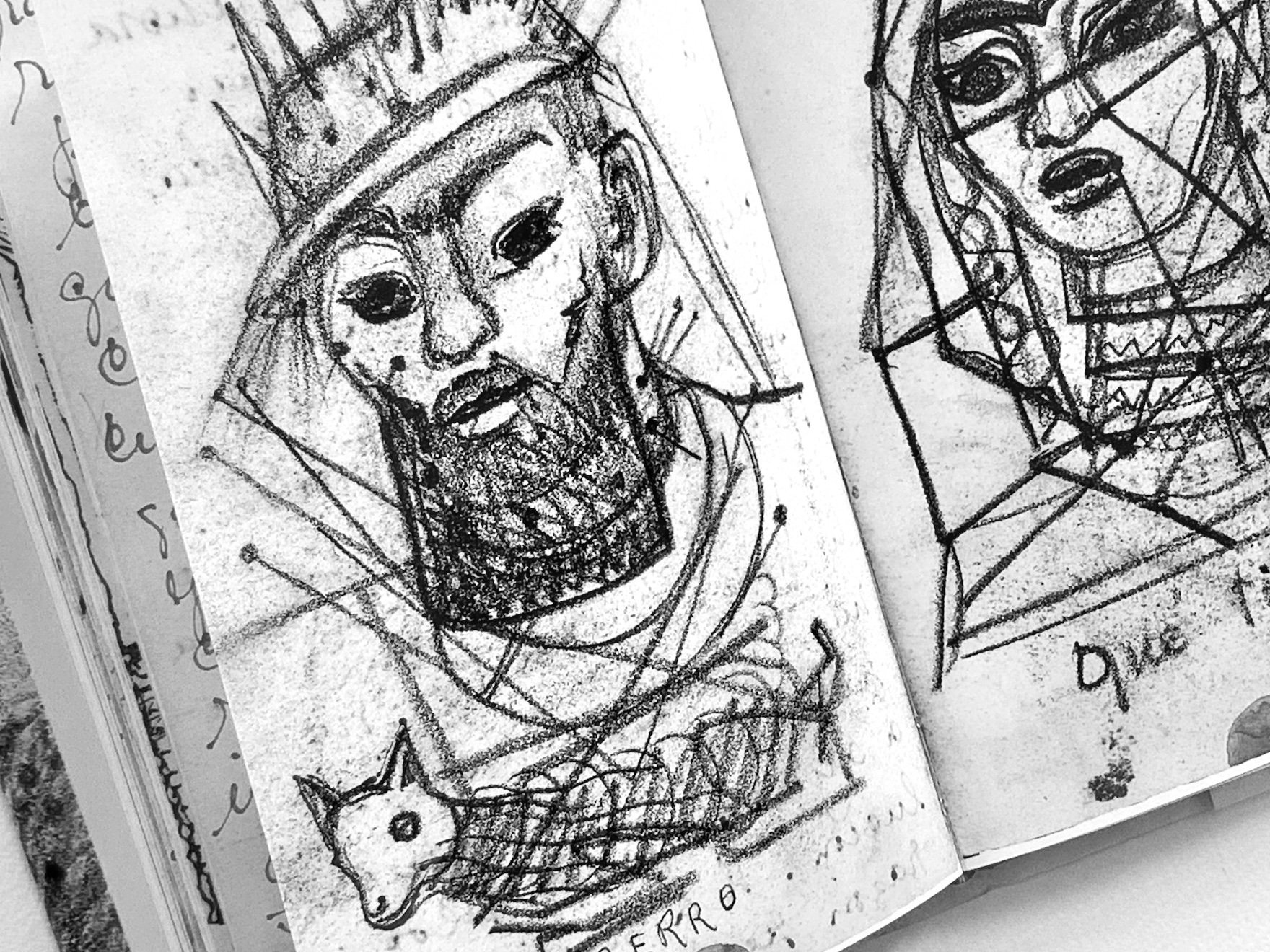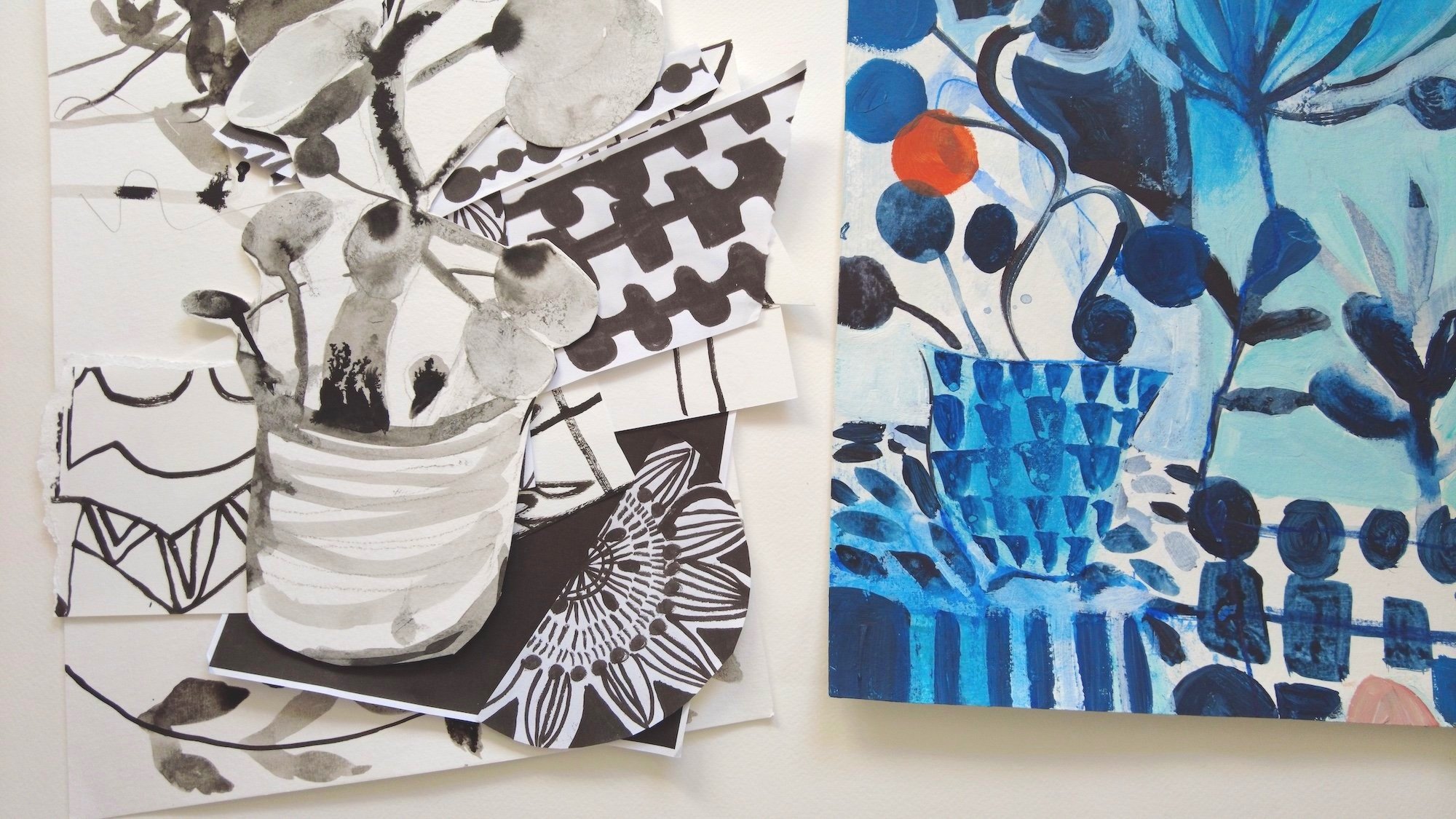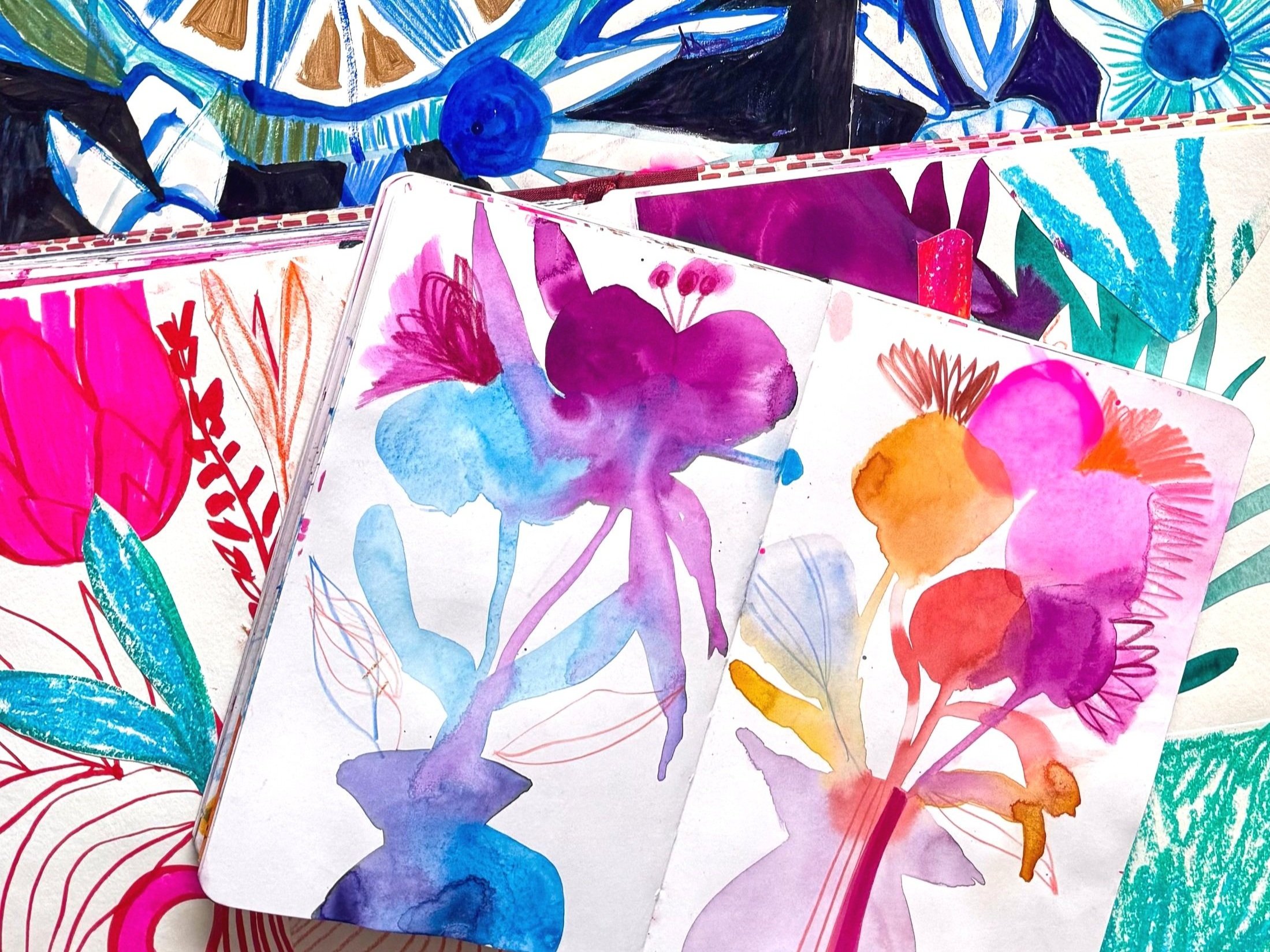
Art making ideasi
Ideas. Inspiration. A little creative mischief.
If you’re drawn to abstract and semi-abstract art, sketchbooks, colour and a little creative mischief, this is your corner of the internet.
In my blog you’ll find stories, videos, inspiration, and gentle nudges to help you create art that feels like you.
The fertile void…
The ebbs and flows of creativity and exploring the fertile void…
This post is about the ebbs and flows of art making.
I rotate through times of productivity and quieter more reflective times. Passages of dynamism and periods of downtime. Times when I’m making complete artworks and times when I’m searching, seeking, preparing…
Creativity ebbs and flows
Sometimes in my art-making there are times when everything feels easy and falls into place and I’m highly productive and then there are times of pause when I’m searching for the next thing... I have learnt that all these states are transient, no season is permanent and perhaps it is just the nature of creativity, it ebbs and flows.
Ideas need time and space to develop and grow. There are times when I am planting seeds unsure if they will become anything and times when my art making bears so much fruit that it feels abundant, verdant and productive.
In any fallow phase there is a need to enrich and prepare the soil, a winter of sorts, where things are slower to take root. I now know that after every Winter there comes a Spring,
The space inbetween things
In art composition there is a concept called negative space or inter-space, where the space in-between and around the subject is as important to the whole as the subject itself, the emptiness is as important as the fullness.
It strikes me that this is often true in the cycles of my art making, the space in-between is important. I can only harvest ideas once I have given them some space to grow.
Artist’s are gardeners
I like this quote from Joan Miró the renowned Spanish artist. He said:
“ I work like a Gardener or a winemaker. Things come slowly. My vocabulary of forms, for example, I didn’t discover it all at once. It formed itself almost in spite of me.” Joan Miró 1958
Seasons of creativity
I find it so helpful to just acknowledge the different seasons that my creativity passes through, to know that some seasons are for planting seeds and some seasons are for growing ideas, whilst at other times I will harvest them.
The fertile void
The analogy of an artist as a gardener is a powerful one, it helps me to see the bigger picture, to get a wider perspective. There is a cyclical nature to creating, to know that seeds that are planted today may take a good while to fully flourish and grow and some may never grow…
Not every season of your creativity will feel abundant, but this doesn’t mean it should be neglected, creating a garden can be a long, yet magical endeavour and the same can be true in art making… it must be nurtured and nourished.
There is a concept in Gestalt Therapy called the Fertile Void which I find really interesting when applied to art making. The space, the pause, the gap in-between things can also be a fertile and powerful place, a place of growth, magic, possibility and potential…
The process of painting: a winding journey
The painting process: pivots and pathways…
Today I want to talk about how paintings can sometimes take a completely unexpected turn. How the art we’ve made previously can inform what we are making today and how sometimes our ideas just take time and many different iterations to get where they are going...
Destination unknown
One small experiment or drawing might lead us somewhere unexpected.
One small starting point, might lead us down a new path, which leads to another path which leads us to somewhere exciting.
In revisiting an old path we find a new route through.
I frequently find that something small can be the catalyst to a whole new body of work. Finding the paths to follow is part of the joy of art making. We have to really pay attention to the things in our own art that are calling to us, notice the things that delight us, bring our own unique combination of fascinations together and combine them in a way that feels personal to us. Art making is often about learning to follow our own internal compass and noticing where it is directing us…
Art Work in Progress…
Bringing together fascinations
The three acrylic paintings I am currently working on started as a response to some quick blue, white and pink painted studies... But as the paintings progressed they took a different path. A few drawings in my sketchbook from several years ago provided a sign post, a catalyst, a compass and the paintings changed direction... These paintings are now a combination of different ideas, from different eras of my art, different experiments combined together to create a new route.
A winding journey
I’ve found in art making, that only rarely do things come to me quickly and fully formed, more often than not we just have to give our art the time and space it needs to unfurl and evolve.
I circle back on a well trodden path and find a new route through,
Combining together ideas and influences. fragments of ideas, something from here and something from there.., following an old path, following a new path, our art making is a journey which sometimes takes us to unexpected and delightful places…
Art making manifesto
A little of what I believe to be true about about art making…
It is useful to think about what we believe when it comes to our own art making.
I wanted to summarise my personal beliefs and be clear about my own philosophy and wisdom. Things about art which I know to be true, the guiding principles behind my practice.
So here it is. My art making manifesto. A set of beliefs in a few short words, but also a set of intentions. A small reminder, a note to myself and perhaps others. A written set of ideas to guide, remind and direct me… my north star of art making.
This is what I believe, you may not agree…
I think it is a useful exercise to document what we believe to be true for ourselves. Define our own wisdom.. Perhaps you may like to try and write your own manifesto and guiding principles.. Just thinking about what we do actually believe to me true can be enlightening.
MAKE MORE ART
The more art we make the better our art becomes. The more art we make the more likely we are to develop skills and ideas. The more art we make the more confident we become in our decisions. The more art we make the better we are able to spot patterns, connections and themes. The more art we make the better we are able to identify reoccurring pre-occupations and fascinations.
SKETCHBOOKS ARE MAGIC
Sketchbooks are a great place to try things out and explore. They are a place to ponder, wonder and play. A place to safely gather together the hints, whispers and clues of an artistic practice. A place to collect and curate small corners and large curiosities, a place to develop skills and processes.
EVERYONE’S AN ARTIST
I believe everyone’s an artist, it’s a natural human instinct to interpret and understand ourselves and the world through creating. Art-making is a skill, developed by practice and not an innate talent which we either have of don’t have.
DEVELOP THROUGH DOING
The idea of art being a ‘practice’ is right, we do indeed have to practice. It is in the action that we discover ways of making art which feel right, that we discover ourselves as artists.
EXPERIMENTATION EQUALS DISCOVERY
I find that the more I experiment the more I am likely to discover things about my own art and the things that excite and interest me. I find it valuable to try things and then reflect on the signposts and signals I find within those experiments….
BE MORE WEIRD
It’s our particular visual quirks and sensibilities, our own peculiar weirdnesses that make our art feel uniquely ours. We should lean into these, whether it be subject matter, process, colour, the way we mix or apply materials. Our weird bits can be our interesting bits, they are part of our artistic voice and style.
INSPIRATION IS EVERYWHERE
Inspiration is everywhere and making art helps us to seek and find what we are personally interested in. Creating art helps me to see the world with new and curious eyes, it brings more wonder and awe into my life. I notice more, pay more attention to details and become more fascinated by random and unexpected beauty in the world around me.
PROCESS OVER PERFECTION
This one is the art making equivalent of “it’s the journey, not the destination.” As artists we all need to develop a selection of processes and methods which feel good, enjoyable and which match our own interests and sensibilities.
DELIGHT YOURSELF FIRST
Rather than think, “Will people like what I’ve made?” perhaps a more useful question is “Am I making art that I truly love?”
Our art is an expression of who we are…
Thoughts on developing our art style…
Music used in video: Softly to Myself by Kylie Dailey
In this video and blog I share some thoughts on developing an art style which feels personal and particular to you.
Our art is an expression of who we are…
Our art is such a personal expression of who we are, our experiences, our fascinations and our curiosities.
In my tutorials and content I am conscious and careful that I don’t want to teach anyone how to make art that looks like mine; I want to encourage, cheerlead and share advice about how to make art that feels and looks wondrously and uniquely yours...
The art we make is an extension of who we are and what we are interested in, so it needs to feel like it belongs to us, that it came from our hand and our heart.
And I think that is what developing our art style is all about, it’s about ensuring our art feels like we’ve made it, it’s about making art which feels completely ours, an expression of us, a reflection of who we are and what we are fascinated and curious about. .
Make lots of art
I frequently get asked about how I developed my style of art and how others should develop theirs. I believe the way to develop your style is to make a lot of art, average art, beautiful art, any art…we have to try things out, experiment, not know where it is taking us…
Seek signposts
It is only when you have made a significant amount of work, become more comfortable in your skills and tried numerous approaches that you can look back through it and see what it is signalling to you. The art you make contains important signposts to your style.
Get inquisitive
Look at a selection of art you have made and get inquisitive and question yourself:
What aspects do I particularly relish?
What appeal to me?
What speaks to me within my own art?
What do I enjoy making?
How do I enjoy making it?
What kind of marks do I relish using?
How does my art feel?
How would I describe my art?
Ask questions about your own art and listen to your answers they contain powerful clues.
Follow the clues
Think about your art, the subject matter, the technique, the materials, the colours, the marks, the feeling that it stirs, paying attention to what we are drawn to in our own art is the key to creating distinctive, personal art that feels like it is ours.
Evolving and changing
Our art style is an ongoing conversation with ourselves, an expression and voice for who we are and what we are interested in. Our art style is not a fixed thing, which we arrive at and never depart from. The way we make art is us sharing our point of view, our opinion, interpreting the world and our place in it…and as such elements of our style will change and evolve and elements will remain constant. I’ve been making art for twenty years now and my style feels to me as if it is in constant slow motion, it changes and evolves and takes on new iterations and elements and sometimes it circles back to themes and ideas…
In one sentence…
To develop our art style we have to make lots of art, reflect on the art we have made, get curious about the aspects of it that light us up and do more of that. It’s a continual process of taking note of what we love within our own creations and doing more of it…
How a painting progresses
A little insight about how paintings evolve and develop…
I’ve been working on some paintings for the last few weeks. In this blog post I wanted to share these paintings with you and give a little insight into my thought process and painting process.
SETTING AN INTENTION
Before I started painting this series I spent some time thinking about the kind of paintings I wanted to make. I looked back at my sketchbooks and previous painted studies. I made a few notes on how I wanted the paintings to feel and be. Setting the broadest of intentions for the work. I wrote ‘dreamlike, bold, interesting objects.”
I chose to use acrylic paint as I wanted to build up layers of paint and for each painting to have a hidden history which occasionally reveals itself.
I also spent some time thinking about the colour palette.…but this changed in the process of making them. And then I started, My one definite plan was to keep coming back to the paintings day after day until they were finished and to use my sketchbooks as a resource and guide rope.
LAYERS OF PAINT
I built up layer after layer of paint, letting each painting take shape and become what it was going to become. These paintings were painted with Sennelier Abstract Acrylic Paint on 360gsm paper from a UK brand called Seawhite of Brighton.
I find when I work with acrylics in this way, it can be a fascinating journey of both discovery and concealment. The fact you can build up layer after layer is what makes painting with acrylics, for me, a dance between flow and frustration. It’s not until the later layers that the painting comes together and reveals itself.
STAGES OF PAINTING
In creating paintings this way, I seem to cycle through phases of ease and effort. The early layers start with a sense of play and possibility. I freely engage with the colours and paint. As I know that only tiny remnants, if any, of these early layers will show through in the final painting, there is a freedom and boldness that comes at the start.
Then comes the difficult middle bit, where it all looks a bit muddled and messy and I’m not sure what to do next. Each painting seems to oscilate between ugly and good looking so quickly. It’s in this middle phase where I am trying to consider composition and work out the direction of each painting and what it might become.
This middle phase always seems like a little bit of a tussle, a rewarding wrangle, I have to paint over sections I love to find a composition that works. Each painting frequently looks bad in this phase and I find it hard to believe it could ever become beautiful. But I persevere and keep going. Some days I leave the studio feeling like the paintings are worse than when I started the day. But then the next day everything just comes together and I can see what they might be.
The final phase of my painting process is where I refine, clarify and resolve each painting. Here I make smaller, less dramatic changes until I am happy that all the paintings are how they should be.
As these paintings progressed I kept thinking about making space, the importance of spaciousness, the sentimental importance of the objects we travel through life with….giving myself space to dream and unfurl. And somehow the final paintings do appear a little dream-like to me.
SPACE TO REFLECT
Once I believe they are all complete and finished, I leave them for a few days or more and keep coming back to them to see if I spot anything that jars, or distracts or doesn’t feel exactly right to me.
This time and space to reflect gives me a new perspective and more objectivity, Looking at them long and hard when I’m not in the process of actually painting them is a helpful thing.
And then believing they could be finished turns into knowing they are finished…. and they are.
Need a little sketchbook inspiration?
Take the Sketchbook Love Class.
It is FREE today
Looking back to go forward…
This blog is about reviewing our work, looking back at our art with an inquisitive and curious eye…
In this video I show you some recent studies, sketches and sketchbooks and chat about how I often review my artwork as a way to take stock and inform my next art making move….
Spending a little time looking back over previous creations is a lovely way to recall, retain and be reminded of things that may have been forgotten and can bring clarity about what to make next.
REMEMBERING AND REMINISCING
Looking back over work we have previously created is like catching up with old friends, remembering and reminiscing.
CONNECTIONS AND COMBINING
When we look at our work collected together we are better able to see connections and themes and ways in which we may like to combine elements and ideas together to create something new.
I find it useful to review my work with an inquisitive eye, asking questions such as:
What do I find interesting here?
What is calling to me?
What do I find visually pleasing? A colour, a mark, a line quality, a combination or juxtaposition?
Why does this appeal to me?
How does it feel?
How do I want my current art to feel?
How could I evolve this?
How could I develop it?
I find that what I have already created holds important signs or signals and reviewing it can ignite something new or prompt me to explore and expand on a theme or technique, spending time ‘mining’ our own creations can be a useful way to better understand our own artistic sensibilities and style.
THE PAST INFORMS THE FUTURE
There is a lovely continuum in art making, everything that we’ve made before, we bring to our new creations, nothing is ever wasted, it’s like everything we’ve already made informs everything to come….and I relish that continuity and evolution…
Need a little sketchbook inspiration?
Take the Sketchbook Love Class.
It is FREE today
Sketchbooks and art books
I share three art books which take you inside renowned artist’s sketchbooks and share a little about my new still life class…
In this video I share a few art books which show you inside the sketchbooks of three renowned artists, I take you inside my latest sketchbook and I chat a little about my new still life class; The Still Life Lab.
Barbara Rae Arctic Sketchbooks, published by the Royal Academy of Art 2023
David Hockney, A Yorkshire Sketchbook, published by The Royal Academy 2011 (Link to examples of Hockney’s sketchbooks on his website)
Picasso Sketchbooks the book showed is called Sketchbooks of Picasso Je Suis Le Cahier by Arnold Glimcher and Marc Glimcher published by Thames and Hudson. 1996 (Link to an article about Picasso’s Sketchbooks)
Need a little sketchbook inspiration?
Take the Sketchbook Love Class
It is FREE today
How to make a simple sketchbook
Learn how to make a simple concertina book which can be turned into a more regular sketchbook with a little glue…
In this video I show you how to make a simple sketchbook from one large piece of paper. The bigger sketchbook in the video is made from an A1 sheet and the smaller one is made from an A3 sheet.
I make these simple one page sketchbooks very frequently and have for many years. There is something extremely tactile and pleasing about making a simple art book. I like the fact that it’s just one piece of paper, no pressure, no expectations, it feels expansive and freeing.
The great thing is that you can make them from any paper you have that you can fold and you can make them from abandoned art experiments or drawings if you’d like to…. in the video I am using paper which is approximately 150gsm in weight.
Art and life: sketchbooks, paintings and art books
Tracing how my sketchbooks influence my paintings and sharing some favourite art books…
In this video I show you some new completed paintings and trace their origin back to some old sketchbook pages. I share a couple of my favourite art books, talk a little about art and life and share some of my latest sketchbook meanderings…
The artists and books I mention:
Angie Lewin: Plants and Places by Angie Lewin, published by Merrell 2010
Barbara Rae: Barbara Rae, words by Bill Hare, Andrew Lambirth & Gareth Wardell, published by Lund Humphries in 2008
Available paintings
Online art classes
Searching for joy and delight
A tour through my mixed media sketchbook and a speedy art demo using Indian ink
Music Credit: Supine by Peter Sandberg via Epidemic Sound.
In this video I take you inside my mixed media sketchbook and share a speedy art demonstration experimenting with ink…
I often write notes to myself about my art, things I want to explore, things to remember, ideas to expand upon, fragments and whispers I want to capture.
Sometimes I list the things I want to do more of or the things I want do less of…
I’ve always found writing to be a useful way to think…by pouring words onto a page, I organise and clarify my thoughts and bring light to what I believe.
Joyful abandon
Recently a phrase has repeated itself in my notes and thoughts in terms of how I want my art to feel. “Joyful abandon.” has appeared twice in my notes… I only noticed it when I read back through them. And then I noticed I’d written it not once, but twice, on different days…in the same week. A subconscious thought made visible.
And what did I mean? I think I meant I want joy and delight to be the things I seek in my art making, my north star…
In this season of my life I want to lean-in to what I find and feel to be joyful…and perhaps abandon the things that don’t support this. There is something unapologetic, exuberant and enthusiastic about the concept of ‘joyful abandon’ that resonates with me. A lack of inhibition and constraint that feels expansive.
When there is so much darkness and difficulty in the world, it may perhaps sound naive of me to be seeking joy. The last few years have been a little challenging for me, I have struggled with some ongoing health issues and various other challenges, and it is exactly this difficulty that has made me more attuned to joy, more keen to seek it out, to celebrate it and appreciate it….
Seek what you value in your art
Creating art isn’t always easy, there will often be problems to solve, fallow seasons, perhaps times when it feels more challenging than others, sometimes art making will feel vulnerable and exposing, we will often get in our own way, but making a decision to seek out what you value the most and do less of the things that don’t serve this seems like a good ambition to me…
Art demo: abstract painting inspired by shapes
A practical tutorial about painting abstract pages inspired by shapes…
Music Credit: Supine by Peter Sandberg via Epidemic Music.
In today’s video I demonstrate a way to build up an abstract painting using layers of acrylic paint and shapes.
In a previous video I shared a drawing exercise which created a grid of shapes. Today I take some of the shapes from that drawing exercise and use them to develop striking abstract painted pages in a sketchbook. It is a method you may want to explore as a way to progress your original drawn ideas and use your repertoire of shapes in a painting. You can watch the original drawing video here if you’d like to:
In today’s painting demonstration I am using heavy body acrylic paint from Sennelier in a Daler Rowney A3 Sketchbook which has 160gsm paper.
This paint has quite a matte finish (although I think it is technically described as satin) so it doesn’t tend to result in sketchbook pages which stick together, some heavy body paint can be quite glossy and it is this shine that results in finished pages sticking together, despite them being dry when you close your sketchbook.
This demo and exercise is messy and playful and it can create interesting and surprising results…(if you enjoy a pristine sketchbook or are at all concerned that the paint you are using might possibly cause your pages to stick together you may want to try this on a piece of paper instead). I hope you enjoy it.
Online art classes
Art tutorial: interesting shapes
A practical tutorial all about discovering and developing interesting shapes…
In this playful and accessible short workshop I share different ways to discover and develop interesting shapes to incorporate into your abstract art. We’ll be exploring ways to find shapes out in the world and 2 x ways to develop your own collection of shapes through simple drawing exercises.
Materials
To complete the drawing exercises you will need some paper or your sketchbook and some drawing materials such as pencils or water based coloured pens.
Books
In the video I show you some work by two artists to get us thinking, Rex Ray and Hilma Af Klint and share inside these two books:
Rex Ray by Griff Willams, Rebecca Solnit and Christian Frock, Chronicle Books 2020
Hilma Af Klint: Visionary, Daniel Birnbaum, Julia Voss et al Stolpe Books 2018
Online art classes
Painting: a process of discovery
Painting is often like setting off on an adventure with no idea of the destination
In this video I chat about how painting can sometimes feel like setting off on a trip with no idea of the destination. When I start painting I can’t always predict the direction the paintings will take. The act of painting can feel like an adventure to an unknown land.
No idea how they will develop…
I’m currently working on a series of new paintings, developing several at once, edging them all forward slowly. Sometimes I enjoy the challenge of a destination which is totally unknown to me, of taking a blank surface and turning it into something alive with paint and colour and pattern… When I started these paintings I had no idea how they were going to develop or what they were going to become. They’re not yet finished, they are still becoming.
Sense of discovery
Sometimes when I create, I have a clear end result in mind, clarity about what I’m creating, I have an idea, a plan and execute on that plan. But in this instance, I set sail with no intended destination in mind. I enjoy the sense of discovery and problem solving which comes with developing a painting with no clear agenda or idea of where I’m going, I take one step, then another and another. I found a quote I had written in one of my old notebooks from the artist Paula Rego which I love.
“You are doing it (painting) to find out what the result will be”
Paula Rego
Sketchbooks: Muscle memory and cataloging
Sometimes this way of painting can feel like jumping out of an aeroplane and hoping the parachute will open. For me my sketchbooks and drawings are my metaphorical parachute. They are the support system that allow me to start with no plan or firm direction of travel.
My sketchbooks are a powerful resource for me, which give me the confidence to start without knowing exactly what I am painting. My drawings help my painting practice in two key ways. Firstly they have helped me to develop a personal visual language, a set of motifs, a way of creating art. So when I come to paint I have all that experience inside me, there’s a muscle memory I can pull on.
And secondly they are a catalogue of my work which I can flick through to remember. I know I can lean on them at any point during the painting process and they will help me to find a direction to follow. I feel safe in embracing the unknown in my painting practice because of what I have created in my sketchbooks…
If you’re looking for an art process to help you create beautiful abstract and semi abstract acrylic paintings from objects in your life, you may like to check out my online art class Objects to Abstracts:
Collages and cardboard cut-outs
Igniting the creative spark…
After any break or pause in art making, I always feel the need to kindle the flame a little, to poke around the embers, to build back my creative momentum and mojo. When we talk about creativity we often use fire analogies. Stoking the flame, igniting the spark, finding what lights our fire... Finding inspiration for our art is a little like tending to the hearth fire. Ideas develop when they are given enough air and enough fuel, nurtured and stoked. So in this video I take you with me as I play about with cardboard, cut outs and paint… sometimes low stakes, low expectation, low pressure exercises are just the thing to reignite my creativity and get me excited about making and creating again…
MATERIALS
The sketchbook in this video is from a British brand called Daler Rowney and it’s an A3 large sketchbook with 160gsm paper. The paint I’m using to paint the cardboard is Abstract Acrylic paint, a heavy body acrylic paint from a French brand called Sennelier with pencil and felt tip pen details.
If you’d like to make more art or try out some some fun new art making techniques, check out my art classes which are all available to take now…
A year of sketchbooks
A year of sketchbooks and thinking about art intentions…
In these videos and blogs I like to share what I’m up to in my art practice and as the year draws to a close I find myself in a reflective mood.
I decided to gather together all the sketchbooks I worked in this year and meander through them with an inquisitive and curious heart. To see what I thought, if anything occurred to me, to see if I could spot signposts for where to go next. To see if my art felt how I wanted it to feel.
Intention setting
This time last year I wrote a few words to help guide my art making in 2023. I defined how I wanted my art and art making to be:
Bold, playful and joyful
Brave and exciting
Unrestricted and unrestrained
Enthusiam and expansion
More exciting and more wild
I can’t say that I’ve nailed this brief. When I see my art gathered together like this, it does feel playful and joyful to me, however I think I have a long way to go in terms of bravery and wildness. I feel like I’m making small incremental moves in the right direction though…
Joining the dots
I often find that looking back helps me to look forward.
My sketchbooks are a safe place where I can store and record my art making and reflect upon it, sift through it and join the dots. My sketchbooks help me to better understand the things about my own art making which interest and fascinate me, the things about the world that interest and fascinate me.
Why I love sketchbooks
Sketchbooks are a place where I make art for myself. The pages are not necessarily filled with ‘sketches,’ the art is not necessarily a draft for something more important, although it can be, I think of my sketchbooks as a place where I experiment and express myself. Sketchbooks are where I gather together the hints, whispers and clues of my artistic practice. Sketchbooks are the filing cabinets for my art making. They are a place to collect and curate small delights and large curiosities. They are a place to make art for the joy of creating, a place to find a path through, problem solve, follow a thread. They are both a homecoming and an adventure…a safe harbour and an adventure playground.
Compound effect
I was slightly astonished by the quantity of work I’ve made in my sketchbooks this year.
I know, as a full-time artist, who is evangelical about sketchbooks and who also teaches sketchbook techniques, I am always going to have a lot of sketchbook work, but the amount surprised even me. I don’t work in my sketchbook every day, and it’s often an hour in the evenings whilst also doing something else. But I do consistently make time for my sketchbook, it’s a valuable practice for me and so I make time for it, even if this is small windows of time.
It is a good reminder that ‘little and often’ has a powerful compounding and cumulative effect. Small actions added together over a year add up to something significant…
One page sketchbooks
Making a small sketchbook from one piece of paper
In this video I show you how to make a simple sketchbook from one piece of paper and a way to tidy them up by gluing and cutting.
I make these simple one page sketchbooks very frequently and have for many years. There is something extremely tactile and pleasing about their intimate scale. I like the fact that it’s just one piece of paper, no pressure, no expectations, it feels expansive and freeing.
The great thing is that you can make them from any paper you have, I happen to have a lot of heavy watercolour paper (350gsm) and I use that but you can use what you have to hand, you could even use cheap computer paper. These sketchbooks end up with 8 sides, so the end result will always be an eighth of the size of the paper you started with…
I sometimes begin the art work before the page is folded into a sketchbook, there is something about the surprising and unexpected compositions that come with the folding which I enjoy.
I’ve made them from abandoned drawings or from scrap pieces of paper, reusing and recycling and making something from not very much. I might take a painting that hasn’t quite worked and use it for the start of one of these art books, adding collage, painting over sections, turning the unloved into the loved.
Thank you to artist Sue Brown for the idea of gluing these sketchbooks. you can of course just make them by folding and one cut if you want to keep them super simple (the gluing helps if you are using thicker paper and want to neaten them up, because thick paper doesn’t fold as well and so the end result can get a little wonky.)
Understanding our art by writing
Writing to gain insight and clarity…
I’m a great believer in writing things down. Sometimes the act of putting pen to paper can turn the intangible into the tangible. Asking ourselves questions and writing down our answers can help us to articulate our intentions and ideas to ourselves. It can help us find clarity when we are a little unclear. Our answers can also serve as a reminder and prompt along the way.
A sketchbook made from one piece of paper
One page sketchbooks
In this video I share how I use one page sketchbooks as art note books.
You can learn how to make a one page sketchbook here if you would like to.
Writing to understand
Writing about our art can help us to organise our thoughts, collect and capture ideas and can give us ideas when we are feeling under-inspired. Here are some questions you may like to use as prompts for your own writing:
What am I interested in exploring?
How do I want my art to feel?
What processes do I want to explore?
What do I want to start/stop doing in my art making?
What artist’s are currently calling to me and why?
What art materials do I want to use?
What advice do I need to give myself?
What can I do to nurture my creativity?
I like to keep adding to my one page notebook as ideas occur to me, I try and capture those fleeting observations before they escape. It creates a useful resource, a map of inspiration and ideas…
The beauty of things
A little background on a recent series of colourful paintings…
In this video I share some insight into a recent series of paintings. This collection of abstract still-life paintings is inspired by some of the objects and things in my home…
“These artworks are loosely inspired by some of the objects and artefacts in my life and home. The objects I find beautiful and the things that have meaning to me.”
HELEN WELLS
Inspired by beautiful things…
I’m fascinated by the objects we travel through life with. Objects that we invite into our lives, into our homes and houses and our connection to those objects. These paintings celebrate that bond and are loosely inspired by some of the things in my home…and evolved from ideas I developed in my sketchbooks.
My sketchbooks are where everything I make starts. They are the birthplace of all my art. They are where my ideas percolate and develop, collect and gather. My sketchbooks are where I experiment and where my ideas unfurl and take shape. They are where I get to understand myself as an artist and where I get to understand the things that excite me and make me curious…
My hope is that these abstract still life paintings bring a moment of joy and invite a smile. They are bold, bright and exuberant…
Sketchbook pages
Inside the art journal of Frida Kahlo
The visual journal of Frida Kahlo…
THE DIARY OF FRIDA KAHLO: AN INTIMATE SELF PORTRAIT
In this video I take you inside the art journal or visual diary of the artist Frida Kahlo. I share the book: The Diary of Frida Kahlo: An Intimate Self Portrait published in 1995 by Abradale Press an in-print of Abrams Books, with subsequent reprints in later years. You can read more about this book on the publisher’s website, it is still in print today…
It’s a book which I come back to time and again.
Frida Kahlo, one of the most iconic artists of the 20th century, was born in Mexico in 1907 and is famous for her self-portraits, characterised by vibrant colours and powerful symbolic imagery,
This book fully replicates 170 pages of her visual journal or sketchbook. She worked in the book for the last ten years of her life between circa 1945 and 1955 and it gives a intimate insight into the woman and the artist.
INTROSPECTION AND EXPRESSION
Her diary or sketchbook, I think, reflects both a deep introspection and bold self-expression. She has clearly used this book as a means of exploring her inner thoughts, emotions, and personal experiences, her identity and her place in the world.
IMAGERY AND SYMBOLISM
It’s packed with symbolic imagery, metaphors, personal, political, religious and cultural iconography all patch-worked together.
Pages from Frida Kahlo’s visual diary
EXPLORATION AND EXPERIMENTATION
It also shows all sorts of artistic exploration and experimentation, she mixes up various techniques, styles, and art materials. She combines elements of realism, surrealism with symbols and motifs to create a visually rich, and at times bewildering and beguiling whole.
I think she is exploring her personal pain and suffering and yet it also clearly demonstrates her magnificent wit, playful spirit and vibrancy…
Her journal feels like a significant work of self-expression, resilience and creativity…and I think it’s just fascinating.
Making collages to inspire paintings
Making collages to inspire paintings…
In this video I share a process I use to help me find new ideas and compositions…
CREATING COLLAGES
I make photocopies of things I’ve created, such as pages in my sketchbook, I collect together abandoned drawings, and offcuts and oddments from my art practice and I use all these pieces and fragments to create temporary collages which I then photograph.
The photographs are then used to inspire further drawings and paintings and then those drawings and paintings might be used to inspire something else…its a creative stepping stone.
A temporary collage made from old drawings, and photocopies of things I’ve created
FOLLOWING A BREADCRUMB TRAIL
Art making is often like following a breadcrumb trail through the forest to an unknown destination… I never quite know which path will lead to something magical and which will lead to a dead-end. I like the fact that making art can feel like a journey into the unknown...
A painting in my sketchbook (left) inspired by a collage made from pieces of an old magazine (right).
COLLAGES MADE FROM MAGAZINES
If you don’t have offcuts of your own art to use to create a collage, you could try with pieces cut from a magazine.
Above is a small collage I’ve created by cutting interesting bits and bobs out of a magazine.
Creating a composition from random found shapes and pieces is like constructing a puzzle… it involves lots of questioning and thought and is not always as easy as it may appear. ‘Does this look balanced? Is this interesting? Is it too busy? Is it too boring? Does it work as a unified whole? The sort of questions you need to ask when creating any art work are tested by this type of excercise. In all these experiments, I’m seeking discoveries, learnings, revelations…flexing my creative muscles.
I believe most artist’s have a seeker’s soul. Looking for fragments of ideas, trying to figure things out, attempting to join the dots, make connections, piecing things together to better understand themselves and the world around them. Trying to find out who they are as artists and how they want their art to look, feel and be in that moment…




